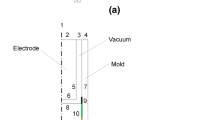Abstract
Controlling the heat transfer rate from solidifying shell to copper mold is one of the important role of mold flux film during continuous casting of steels. It is highly desirable to regulate the thermal resistance of mold flux film not to exceed the critical quantity of mold heat transfer rate to prevent cast steel products from surface defects. In order to examine the effect of thermal radiation on the overall heat transfer rate through slag film in the continuous casting mold, the absorption coefficient has been investigated for various mold fluxes using a UV and an FT-IR spectrometer, followed by numerical calculations based on gray gas assumption. It is estimated that the heat transfer rate will decrease in 2-4% by addition of 3.2 mass% NiO into the conventional mold flux system with basicity (CaO/SiO2) of 1.07. As the increase of absorption coefficients will not be harmful to any casting performances such as friction in a casting mold, it is highly recommended to enhance the thermal radiative absorption behavior of mold slag film by optimizing the chemistry of mold fluxes, especially in the wavelength range of 1 to 3 µm at which the emitted energy intensity from steel shell will be maximized.
Similar content being viewed by others
References
J. W. Cho, T. Emi, H. Shibata, and M. Suzuki, ISIJ Int. 38, 268 (1998).
S. Ohmiya, K. H. Tacke, and K. Schwerdtfeger, Ironmak. Steelmak. 10, 24 (1983).
J. W. Cho, T. Emi, H. Shibata, and M. Suzuki, ISIJ Int. 38, 440 (1998).
W. Wang, L. Zhou, and G. Kezhuan, Met. Mater. Int. 16, 913 (2010).
J. W. Cho, T. Emi, H. Shibata, and M. Suzuki, ISIJ Int. 38, 843 (1998).
E. Y. Ko, J. Choi, J. Y. Park, and I. Shon, Met. Mater. Int. 20, 141 (2014).
J. Y. Park, E. Y. Ko, J. Choi, and I. Shon, Met. Mater. Int. 20, 1103 (2014).
J. Diao, B. Xie, J. Xiao, and C. Ji, ISIJ Int. 49, 1710 (2009).
J. W. Cho and H. Shibata, J. Non-Cryst. Solids, 282, 110 (2001).
J. W. Cho, K. Blazek, M. Frazee, H. B. Yin, J. H. Park, and S.W. Moon, ISIJ Int. 53, 62 (2013).
W. Wang, K. Gu, L. Zhou, F. Ma, I. Sohn, D. J. Min, H. Matsuura, and F. Tsukihashi, ISIJ Int. 51, 1838 (2011).
M. Susa, K. Nagata, and K. C. Mills, Ironmak. Steelmak. 20, 372 (1993).
M. Susa, A. Kushimoto, H. Toyota, M. Hayashi, R. Endo, and Y. Kobayashi, ISIJ Int. 49, 1722 (2009).
R. Siegel and J. R. Howell, Thermal Radiation Heat Transfer, 2nd ed., pp.412–447, Hemisphere Pub. Corp., Washington (1981).
K. Kusabiraki and Y. Shiraishi, J. Jpn. Inst. Met. 45, 250 (1981).
K. Kusabiraki and Y. Shiraishi, J. Jpn. Inst. Met. 45, 888 (1981).
K. Kusabiraki and Y. Shiraishi, J. Jpn. Inst. Met. 45, 259 (1981).
I. C. Hisatsune and N. H. Suarez, Inorg. Chem. 3, 171 (1964).
J. S. Berkes and W. B. White, Phys. Chem. Glasses, 7, 191 (1966).
M. Hayashi, M. Susa, T. Oki, and K. Nagata, ISIJ Int. 37, 126 (1997).
T. Mizoguchi, S. Ogibayashi, and T. Kajitani, Tetsu-to-Hagane 81, 971 (1995).
K. Kobayashi, Thermophysical Properties Handbook, p.23, Yokendo, Tokyo (1990).
Y. Kawai and Y. Shiraishi, Handbook of Physico-chemical Properties at High Temperature, p.241, ISIJ, Tokyo (1988).
H. Ohta, M. Masuda, K. Watanabe, K. Nakajima, H. Shibata, and Y. Yaseda, Tetsu-to-Hagane 80, 463 (1994).
Y. Kang and K. Morita, ISIJ Int. 46, 420 (2006).
S. Bagha, N. C. Machingawuta, and P. Grieveson, Proc. 3rd Int. Conf. on Molten Slags, Fluxes and Salts, p.235, ISS, Glasgow (1988).
M. Hanao, M. Kawamoto, and A. Yamanaka, ISIJ Int. 52, 1310 (2012).
M. Susa, A. Kushimoto, R. Endo, and Y. Kobayashi, ISIJ Int. 51, 1587 (2011).
Author information
Authors and Affiliations
Corresponding author
Rights and permissions
About this article
Cite this article
Yoon, DW., Cho, JW. & Kim, SH. Assessment of heat transfer through mold slag film considering radiative absorption behavior of mold fluxes. Met. Mater. Int. 21, 580–587 (2015). https://doi.org/10.1007/s12540-015-4448-0
Received:
Accepted:
Published:
Issue Date:
DOI: https://doi.org/10.1007/s12540-015-4448-0




